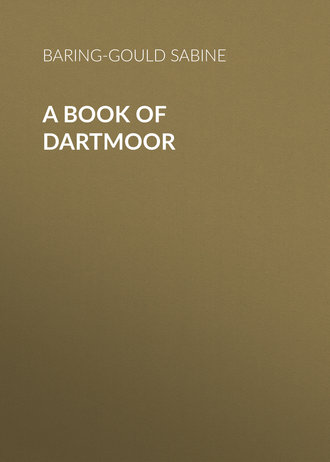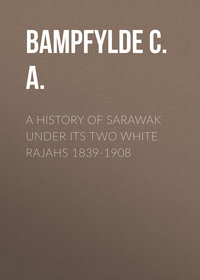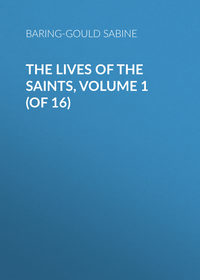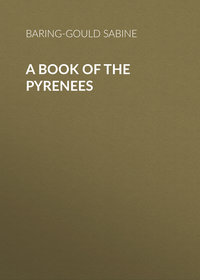 полная версия
полная версияA Book of Dartmoor
In North Germany a troublesome ghost is bagged, and the bag is emptied in some lone spot, or in the garden of a neighbour against whom a grudge is entertained.
Another mode of getting rid of the spirit of the dear departed is to confuse it as to its way home. This is done in various ways. Sometimes the road by which it has been carried to its resting-place is swept to efface the footprints, and a false track is made into a wood or on to a moor so that the ghost may take the wrong road. Sometimes ashes are strewn on the way to hide the footprints. Sometimes the dead is carried rapidly three or four times round the house so as to make him giddy and not know in which direction he is carried.10 The universal practice of closing the eyes of the dead may be taken to have originated in the desire that he might be prevented from seeing his way.
In places it was, as already said, customary for the dead body to be taken out of the house, not through the door, but by a hole knocked in the wall for the purpose, and backwards. In Corea, blinders made of black silk are put on the dead man's eyes, to prevent him from finding his way home.
Many savage nations entirely abandon a hut or a camp in which a death has occurred for precisely the same reason – of throwing the dead man's spirit into confusion as to its way home.
It was a common practice in England till quite recently for the room in which a death had occurred to be closed for some time, and this is merely a survival of the custom of abandoning the place where a spirit has left the body. The Esquimaux take out their dying relatives to huts constructed of blocks of ice or snow, and leave them there to expire, for ghosts are as stupid as they are troublesome; they have no more wits than a peacock, they can only find their way to the place where they died.
Other usages are to divert a stream and bury the corpse in the river-bed, or lay it beyond running water, which, according to ghost-lore, it cannot pass. Or, again, fires are lighted across its path, and it shrinks from passing through flames. As for water, ghosts loathe it. Among the Matamba negroes a widow is flung into the water and dipped repeatedly so as to wash off the ghost of the dead husband, which is supposed to be clinging to her. In New Zealand, among the Maoris, all who have followed the corpse dive into water so as to throw off the ghost which is sneaking home after them. In Tahiti, all who have assisted at a burial run as hard as they can to the sea and take headers into it for the same object. It is the same in New Guinea. We see the same idea reduced to a mere form in ancient Rome, where, in place of the dive through water, a vessel of water was carried twice round those who had followed the corpse, and they were sprinkled. The custom of washing for purification after a funeral practised by the Jews is a reminiscence of the usage, with a novel explanation given to it.
In the South Pacific, in the Hervey Islands, after a death, men turn out to pummel and fight the returning spirit, and give it a good drubbing in the air.
Now perhaps the reader may have been brought to understand what the sundry mourning costumes originally meant. They were disguises whereby to deceive the ghosts, so that they might not recognise and pester with their undesired attentions the relatives who live. Indians who are wont to paint themselves habitually, go after a funeral totally un-bedecked with colour. On the other hand, other savages daub themselves fantastically with various colours, making themselves as unlike to what they were previously as is possible. The Coreans, when in mourning, assume hats with low rims that conceal their features.
The Papuans conceal themselves under extinguishers made of banana leaves. Elsewhere in New Guinea they envelop themselves in a wicker-work frame in which they can hardly walk. Among the Mpongues of Western Africa, those who on ordinary occasions wear garments, when suffering bereavement walk in complete nudity. Valerius Maximus tells us that among the Lycians it was customary in mourning for the men to disguise themselves in women's garments.
The custom of cutting the hair short, and of scratching and disfiguring the face, and of rending the garments, all originated from the same thought – to make the survivors unrecognisable by the ghost of the deceased. Plutarch asserts that the Sacæ, after a death, went down into pits and hid themselves for days from the light of the sun. Australian widows near the north-west bend of the Murray shave their heads and plaster them with pipe-clay, which, when dry, forms a close-fitting skull-cap. The spirit of the late lamented, on returning to his better half, either does not recognise his spouse, or is so disgusted with her appearance that he leaves her for ever.
There is almost no end to the expedients adopted for getting rid of the dead. Piles of stones are heaped over them, they are buried deep in the earth, they are walled up in natural caves, they are inclosed in megalithic structures, they are burned, they are sunk in the sea. They are threatened, they are cajoled, they are hoodwinked. Every sort of trickery is had recourse to throw them off the scent of home and to displease them with their living relations.
The wives, horses, dogs slain and buried with them, the copious supplies of food and drink laid on their graves, are bribes to induce them to be content with their situation. Nay, further, in very many places no food may be eaten in the house of mourning for many days after an interment. The object, of course, is to disappoint the returning spirit, which comes seeking a meal, finds none; comes again next day, finds none again; and after a while out of sheer disgust desists from returning.
A vast amount of misdirected ingenuity is expended in bamboozling and bullying the unhappy ghosts; but the feature most striking in these proceedings is the unanimous agreement in considering these ghosts as such imbeciles. When they put off their outward husk, they divest themselves of all that cunning which is the form that intelligence takes in the savage. Not only so, but, although they remember and crave after home comforts, they absolutely forget the tricks they had themselves played on the souls of the dead in their own lifetime; they walk and blunder into the traps which they had themselves laid for other ghosts in the days of their flesh.
Perhaps the lowest abyss of dunderheadedness they have been supposed to reach is when made to mistake their own identity. Recently, near Mentone, a series of prehistoric interments in caves has been exposed. They reveal the dead men as having had their heads daubed over with red oxide of iron. Still extant races of savages paint, plaster, and disfigure their dead. The prehistoric Greeks masked them. The Aztecs masked their deceased kings, and the Siamese do so still. We cannot say with absolute certainty what the object is, but we are probably not far out when we conjecture the purpose to be to make the dead forget who they are when they look at their reflection in the water. There was a favourite song sung some sixty years ago relative to a little old woman who got "muzzy." Whilst in this condition some naughty boys cut her skirts at her knees. When she woke up and saw her condition, "Lawk!" said the little old woman, "this never is me!" And certain ancient peoples treated their dead in something the same way; they disguised and disfigured them so that each ghost on waking up might exclaim, "Lawk! this never is me!" And so, having lost its identity, the soul did not consider that it had a right to revisit its old home and molest its old acquaintances.
CHAPTER VII
THE CAMPS
No camps in the forest – All on the confines – No apprehension of attack from the south – Whit Tor – The exploration of the camp – How the walls were constructed – This explains their ruinous condition – Brent Tor formerly a camp – How a road up it was made – The Dewerstone camp – Earthen camps – Hembury – The Galford Down camp – A Saxon thegn's burrh – Old Squire Bidlake – Lydford fortifications.
As I have already said, the inhabitants of Dartmoor in prehistoric times seem to have been of a peaceable disposition. There are pounds to contain cattle and protect them against wolves, but no camps on the moor itself. What camps there are will be found on its confines, as though the natives feared attack from an enemy outside, but were not troubled by their neighbours of the same blood and pursuits.
Of camps there are two sorts, but we cannot be sure that they belong to different races of men. The stone-walled fortresses are few – Brent Tor, Whit Tor, Cranbrook, one near Ashburton, and the Dewerstone. Of earth, or earth and stone mixed, there are more. A small one above Tavistock, an immense and very important one at Galford or Burleigh in Bridestowe, one above the station at Okehampton, Wooston and Prestonbury on the Teign, Holne and Hembury on the Dart. Along the south of the moor are none till we reach Boringdon, between the Plym and the Tory. But one only of all these has been systematically explored, and that is, perhaps, the finest, on Whit Tor, above Mary and Peter Tavy.
Whit Tor rises to the height of 1,526 feet above the sea-level. It is on Cudlipptown Down, and commands exceedingly fine views westward as far as the distant Cornish hills.
The tor is not of granite, but of gabbro, an eruptive igneous rock, very black and hard, and splitting along defined planes under the action of the weather. The north side near the summit is covered with a clitter of broken masses.
The boldest masses of rock rise on the south precipitously, but there are fangs of rock that shoot up over the small plateau that forms the summit of the hill.
The whole of the summit is surrounded by a double wall in a very ruinous condition, and this is to a considerable extent due to the smallness of the stones of which it was composed. The faces of the walls were to be traced only by digging, and were never more than doubtful.
Both walls appear to have been 10 feet thick, perhaps a little more; the outer, when perfect, might have had a height of 4 to 4½ feet, whilst the inner, judged by the débris, appears to have been 6 to 7 feet high.
The space between the walls varied, owing to the inequalities of the ground, but was generally 10 feet wide.
The area inclosed by the innermost wall amounts to close on one and a half acres; the total amount included within the outer wall is about two and a half acres of ground.
The circumference is very much broken up, as is also the inclosed area, by considerable masses of protruding rocks. About these, within the camp, heaps of small stones had been piled up, forming cairns. The largest and most notable of these is at the south-west, and consists of a core of rock about which an immense accumulation of stones has been heaped. All these cairns were thoroughly explored. They covered no interments, and although they disclosed evidences that fires had been lighted against the rocks, and that people had camped there for a while, they showed no tokens of structural erection, as though they were ruinous huts built against the native rock. The huge cairn was removed with great labour, and revealed nothing whatever beneath it but one flint flake.
These cairns, there can be little doubt, were collections of stones for the use of the besieged, to serve as missiles, or for the repair of the walls.
Within the area of the camp are a few hut circles. One near the centre is double, and contained an incredible number of flint chips, a flint scraper, and a core from which flakes had been struck. The whole area is littered with flint chips that are brought up by the moles when making their burrows, and curiously enough not a single arrow-head or flake that can be confidently set down as a weapon has been disinterred. The pottery found is all of the hand-made cooking-vessel type.
To the east is a circle sheltered on one side by a mass of rock, that has a second chamber, a sort of bedroom made under a slab of rock, with the interstices on all sides built up, except only on that by which it was entered from the hut. A good deal of flint was found there. Outside, on the south, was another hut circle, where a piece of clear quartz crystal was found, together with a flint knife that had one edge serrated by use.
Connected with the camp on the north-east is a ruined wall that leads to an inclosure with numerous hut circles. South-west of the camp further down the hill is a pound in good preservation with eight hut circles in it. A reeve or bank to the west of the camp leads down to other collections of habitations of the same description.
Some ten cairns on the slopes have been investigated, but have yielded little beyond the handful of ashes sunk in a pit in the centre that represents the dead. A ruined kistvaen, much mutilated, lies between the camp and the Langstone, a menhir that gives its name to the common, and which is the starting-point of a stone row of very inconsiderable blocks that led to a cairn now demolished, and its place occupied by a pool. From Langstone a track to the south-east leads by the head of the Peter Tavy stream, which rises in a bog, to a fine circle of standing stones, and on the slope below that and above the Walkham river is a large settlement of some thirty or forty habitations. Beyond the Peter Tavy brook, moreover, are numerous clusters of dwellings. To all the population who lived in these huts, Whit Tor had served as a camp of refuge. The place deserves a visit, for we have there collected within a small radius the houses and hamlets occupied by the primeval race, the tombs of their dead, the stone row set up in memory of some chief represented by the Longstone towering above the petty stones below, the circle in which the dead were burned, and finally, the camp to which they flew to defend their beloved moor from invasion.
It may cause some surprise that the walls of the stone castles should be in such complete ruin. But, in all likelihood, they were constructed on the same principle as the Gaulish camps described by Cæsar. They were built of timber frames packed in with stones, and the logs mortised together held the stones in place. When, however, the wood rotted, this mode of construction ensured and precipitated utter ruin. At Murcens, in the department of Lot, is one of these stone camps, and sufficiently well preserved, owing to the size of the limestone slabs employed in the building, to show precisely how the whole was constructed. But the walls of Iosolodunum, that held out so bravely against Cæsar, being built of small stones compacted with timber, are now but heaps of ruin, no better than those of Whit Tor.
Brent Tor was fortified in a manner very similar to Whit Tor; the outer wall remains fairly perfect on the north side, but the inner wall has been much injured. In this instance it is not the summit, but the base of the hill that has been defended. As there is a church on the summit, as also a churchyard with its wall, these have drawn their supplies from the circumvallation. Moreover, it has been broken through to form a way up to the church.
A late curate of Tavistock, whose function it was to take the service on Brent Tor, and who found it often desperate work to scramble to the summit in storm and sleet and rain, resolved on forming a roadway to the churchyard gate. But he experienced some difficulty in persuading men to go out from Tavistock to work at this churchway. However, he supplied himself with several bottles of whisky, and when he saw a sturdy labourer standing idle in the market-place he invited him into his lodgings and plied him with hot grog, till the man in a moist and smiling condition assented to the proposition that he should give a day to the Brent Tor path. By this means it was made. The curate was wont to say: "Hannibal cut his way through the Alps with vinegar; I hewed mine over Brent Tor with prime usquebaugh." Few traces of this way remain, but in making it sad mischief was made with the inner wall of the fortress.
On Brent Tor summit it is sometimes impossible to stand against the wind. I remember how that on one occasion a baptismal party mounted it in driving rain. The father carried the child, and he wore for the occasion a new blue jersey. When the poor babe was presented at the font it was not only streaming with water, but its sopped white garments had become blue with the stain from the father's jersey.
On an occasion of a funeral, when the parson emerged from the church door he was all but prostrated by the north-west blast, and he and the funeral party had to proceed to the grave much like frogs. "Crook'y down, sir!" was the sexton's advice; and the whole company had to press forward bent double, and to finish the service seated in the "lew" of headstones.
According to popular belief the graves, which are cut in the volcanic tufa, fill with water, and the dead dissolve into a sort of soup. But this is not true; the rock is dry and porous. It discharges its drainage by a little spring on the north-east that in process of ages has worked itself from stage to stage lower down the hill.
The Dewerstone Camp consists of two stone walls drawn across the headland. No walls were needed for the sides that were precipitous. Cranbrook Castle is in very good preservation, except on the side towards the Teign, where it has been removed by road-menders, but not within recent years. It richly deserves to be investigated, and the owners have recently granted permission to do so to the Dartmoor Exploration Committee.
We come next to the earthen-banked camps. Of these there is a very fine example at Hembury, near Buckfastleigh. But the finest of all is in Burleigh Wood, in the parish of Bridestowe. Here the side accessible from Galford Down has been cut through, with a trench and a bank thrown up on the camp side, and this is carried right across the neck. The earthen banks were almost certainly crested with palisades. Hard by this early camp, where a bronze palstave has been found, is another of a different character, occupying the extreme point of the hill. This consists of a tump or mound, with an earthwork round it as a ring. In this are remains of iron-smelting.
There can be little doubt as to the period of this latter. It was the burrh of the Anglo-Saxon, and was in every point similar to the mottes of the Merovingians in France. On the Bayeux tapestry three fortified places are represented – Dinan, Dol, and Rennes – and all are of the same type. A mound of earth was either thrown up, or a hilltop was artificially shaped like a tumulus. On the top of this the thegn erected his fortress of wood. In the Bayeux representations the superstructures at Dol and Rennes are of timber, and that of Dinan is partly of timber and partly of stone. A flying bridge of wood led from the gate in the palisading of the outer ring, supported on posts, and conducted by an incline to the gate of the citadel. An example of one of these camps at Bishopston in Gower has been explored recently.11 The stumps of the pales were there found embedded in the clay of the bank, in tolerable preservation.
In the valley below Burleigh Camp, commanding the ancient road from Exeter by Okehampton to Launceston, was a third camp, that has been for the most part obliterated; it occupied a rising knoll of limestone, and this latter has been quarried, so that the camp earthworks have been either destroyed or buried under the accumulations from the quarry.
The locality is of great interest. The ridge goes by the name of Galford, and there is reason to think that this was the Gavulford of the Anglo-Saxon Chronicle, where, in 823, the Britons made their last stand against Egbert and the Saxons of Devon.
The place is by nature very strong, and it dominates two roads, that from Exeter to Cornwall, and that which branched off from it on Sourton Down and struck through Sourton to Lydford. The name Gavulford signifies the holdfast on the fordd or road.
Burleigh Camp is on the estate of Bidlake, an interesting old manor house, long the residence of a family of the same name, and deserving a visit. Old Squire Bidlake was a zealous Royalist, and the Parliamentary soldiers went to his house to seize him. As they entered the avenue they met an elderly tramp in rags, and said, "You fellow. Have you seen Squire Bidlake?"
"Yes," he replied; "I've just come from the house, and when I was there he was in it."
Then he went his way, and not till too late did they discover that this tramp was Squire Bidlake himself slipping away in disguise.
He fled to Burleigh Wood. There is a little farm below it, in which, at the time, lived a tenant of the name of Veale. Veale and his wife and daughter concealed him in the underwood, and daily conveyed to him food, and supplied him with blankets till the search for him ceased.
At the Restoration, Squire Bidlake made over the farm to the Veales on a nominal rent, to be held by them on this rent so long as a male Veale of their descent remained to hold it.
Both Bidlakes and Veales are now gone, and the little farmhouse is a ruin. Squire Bidlake is supposed still to haunt the wood, and children are frightened by their mothers with the threat that the old squire will come and fetch them, if naughty.
Lydford was strongly defended. It occupies a fringe of land between ravines, and lines of fortification were drawn across the neck. These may still be traced. The castle stands on a tump artificially shaped. Beyond the church is another small camp, probably British. The castle itself is a structure of stone, replacing the old Saxon burrh.
It was probably from the bridges leading up into these citadels, which the Norsemen saw when they harried our coasts, that they conceived the idea that the rainbow was the great bridge leading up into Odin's Valhalla.
"What fools the gods must be," says the inquirer in the Edda, "to build their passage of egress and ingress of such brittle stuff."
CHAPTER VIII
TIN-STREAMING
Remains of the tin-streamers – Dartmoor stream tin – Lode tin – The dweller in the hut circles did not work the tin – The tin trade with Britain – How tin was extracted – A furnace – Deep Swincombe – Blowing-houses – The wheel introduced in the reign of Elizabeth – Japanese primitive methods – Numerous blowing-house ruins – The tin-mould stones – Merrivale Bridge – King's Oven – Its present condition – Mining.
No one who has eyes in his head, and considers what he sees, if he has been on Dartmoor, can have failed to observe how that every stream-bed has been turned over, and how that every hollow in a hillside is furrowed.
The tin-streamers who thus scarred the face of the moor carried on their works far down below where the rivers debouch from the moor on to the lowlands, but there the evidences of their toil have been effaced by culture.
The tin found in the detritus of streams is the oxide, and is far purer than tin found in the lode. Mining for tin was pursued on Dartmoor during the Middle Ages to a limited extent only, and solely when the stream tin was exhausted.
A very interesting excursion may be made from Douseland Station up the Meavy valley to Nosworthy Bridge, above which several old tin-moulds may be seen lying in the track beside the river, and tin-workings are passed. But perhaps the most interesting portion of the walk is that up the Nillacombe that opens on to the Meavy from the right below Kingset.
Above this the stream has been turned about and its bed torn up, and rubble heaped in huge piles. Not only so, but the hill-slope to the south is marked as with confluent smallpox, the result of the gropings of miners after tin. They followed up every trickle from the side and dug costeening, or shoding, pits everywhere in search of metal.
The upper waters of the Webburn have in like manner been explored, and some idea of the extent to which the moor was lacerated by the miners may be obtained from the Warren Inn on the road from Post Bridge to Moreton, looking east, when the slopes of Headland Warren and Challacombe will be seen seamed deeply.
The remains of the tinners have not been subjected to as full an exploration as they merit, but certain results have nevertheless been reached. One thing is abundantly clear, that all the tin-streaming was done subsequently to the time when men occupied the hut circles. The population living in them knew nothing of tin.









